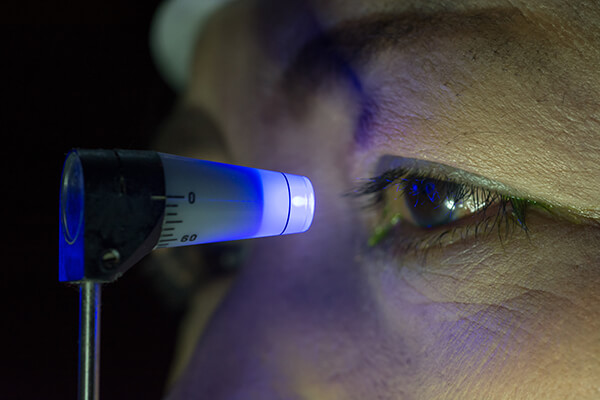

Glaucoma refers to a group of eye diseases that damage the optic nerve, which is essential for vision by connecting the eye to the brain. The vision loss that occurs with glaucoma is irreversible but can be prevented or slowed down with early diagnosis and treatment. While anyone could develop glaucoma, individuals at greater risk are older, have a family history of glaucoma, are members of certain racial or ethnic groups (e.g., African American, Latino, or Asian), have increased eye pressures, or have a history of eye trauma.

Most of the time, glaucoma does not cause any symptoms until the disease is in an advanced stage. Initially, vision loss typically occurs in the peripheral (side) vision where it goes unnoticed. If untreated, glaucoma is usually slowly progressing, eventually causing painless blurring of vision. Less commonly, glaucoma leads to a more rapid increase in eye pressure associated with sudden onset blurry vision, severe eye pain, eye redness, headache, nausea, or vomiting. If these symptoms occur, this is an eye emergency and requires immediate medical attention.
The diagnosis of glaucoma starts with a complete eye exam. Your eye doctor will pay special attention to your eye pressure, the front of your eye, and your optic nerve. Depending on what your doctor sees, you may have additional testing performed including a photo of the optic nerve and a visual field (peripheral vision) test. These non-invasive tests will be done in our office on the initial visit or at a future visit. Not everyone who is monitored for glaucoma needs treatment. Some individuals are glaucoma suspects, meaning they have risk factors for glaucoma but no signs of optic nerve damage and only need closer follow-up.

Because vision loss from glaucoma is irreversible, the primary goal of treatment is to prevent or slow down vision loss by lowering eye pressure. There are multiple ways to do this, usually starting with eye drops or an in-office painless laser procedure called selective laser trabeculoplasty (SLT). You may also be a candidate for a newer glaucoma medication delivery system that could reduce or eliminate your need for drops.
For individuals whose eye pressure is not low enough with using medications or laser, your doctor may recommend glaucoma surgery. Micro-incisional glaucoma surgeries (MIGS), trabeculectomy, and tube shunts are possible surgical options depending on your type of glaucoma and its severity. Glaucoma surgery may also be combined with cataract surgery to control your eye pressure and to potentially reduce your need for glaucoma medications.

There have never been more options for managing glaucoma and preventing vision loss. Trust your glaucoma care to the experienced ophthalmologists at Society Hill Ophthalmic Associates. Call 215-829-5311 to schedule your appointment today.